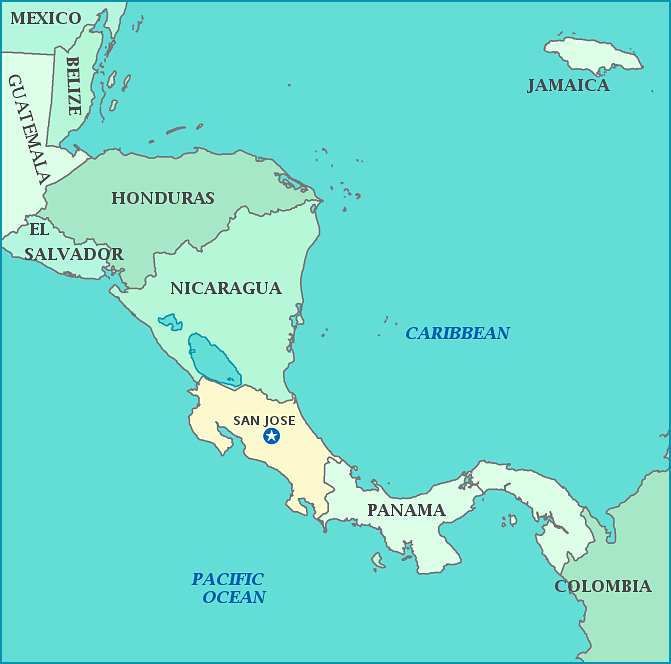It’s the country with no
army. And one of the greenest countries. And one of the happiest places in the
world. Literally meaning “rich coast,” Costa Rica lies in Central America,
between Panama and Nicaragua, touching both the Caribbean Sea and the Pacific
Ocean. As part of the Ring of
Fire, Costa Rica is home to several volcanoes (some are still active), the
highest being Irazú Volcano. Its tropical climate is partly the cause of it
being one of the most ecologically diverse countries in the world.
It’s not exactly sure
who gave Costa Rica its name, whether it was Christopher Columbus or other
Spanish conquistadors who landed later. It was mostly controlled under the
Guatemalan province of the Viceroyalty of New Spain (what is now Mexico). And
then it was part of the Viceroyalty of New Grenada (what is now Colombia) for a
while. The country pretty much lacked all of the things the Spanish were
looking for – namely silver and gold – so they in turn pretty much left it
alone. It was generally thought to be one of the poorest areas in all of
Spanish-run America. When Spain lost the Mexican War for Independence, things
started changing quickly. Costa Rica changed occupiers several times before
gaining its own independence in 1847. In 1948, a dispute regarding an election
led to a 44-day civil war, which led to the deaths of nearly 2000 people. The
next year, the entire army was abolished. Since then, the country has enjoyed
relatively peaceful times. In
fact, last year, they even abolished recreational hunting. (The US South has
probably crossed them off of their vacation destinations. – I’m joking, for
crying out loud. Although it’s probably truer than not.)
The Central Valley is
home to Costa Rica’s largest city and capital, San José. The metro area has
about 2.1 million people – about the same size as Houston, Texas. Most people
live in the suburbs and work in the city, but even at that, it’s one of the
safest cities in that region. It’s quite the center for cultural arts: home to
several colleges and universities, theatres, museums, parks, zoos, as well as
stadiums and sports arenas and of course, the center of government.
Because it was
originally claimed under Spanish rule, the most widely spoken language is
Spanish. However, two of the more
commonly spoken indigenous languages – Mekatelyu and Bribri – are also
recognized as regional languages. Mekatelyu is actually a Jamaican Creole that
was brought to Costa Rica by Jamaicans who moved to the area as migrant
workers. It is actually a transliteration of the phrase “make I tell you,”
which is loosely “translated” as “let me tell you” in standard English. Bribri
is the language spoken by the Bribri people native to Costa Rica.
Unfortunately, there are only about 11,000 speakers left. English is also
learned in school because of its importance as a global lingua franca and
tourism and is understood by many Costa Ricans.
Like most countries in
Central and South America, Roman Catholicism is the dominant religion, followed
by Protestantism (which together make up about 84% of the population). However,
the growing number of other ideologies that are practiced freely in Costa Rica
seems to rise. About 11% of people consider themselves irreligious, not having
any particular feeling towards any one religion at all; about 2% practice
Buddhism, and the bottom 2% follow a variety of other ideologies, religions,
and philosophies.
Costa Rica is a
developing country, just recently opening its doors to global companies like
GlaxoSmithKlein, Intel, and Proctor & Gambel. It also is famous for its
coffee beans, most notably the Costa Rica Tarrazú beans. I have some of this
right now. It’s a little more bright-flavored than others, usually a
medium-dark coffee. I really like it. Costa Rica has also grown to be a popular
destination for ecotourism, tours set up specifically surrounding its flora and
fauna.
This is one country that
has a lot to boast about. It has one of the lowest death rates in the world. About
97% of the country has access to clean water, and 95% has adequate sanitation, which
helps in lowering the risk of infectious disease to an intermediate level. Because
it’s a tropical country, certain diseases such as dengue fever and bacterial
diarrhea are still found though.
The AIDS rate is also fairly low. Since the country enacted it’s own
version of Social Security in 1941, it also granted its wage-earners universal
health care. (However, waiting lists tend to be long to see certain specialists
and so on, so people can choose their own private health insurance to avoid
these waits.)
I know a couple of
people who have been to Costa Rica (one of whom has told me the beer Imperial
is the best!), and from this preliminary reading, I’m completely
intrigued. I think I’d be happy
there. (Only three more decades until retirement!) Well, for one, I’m always a
little happy with a country that votes for a woman as president (we’re
still waiting for one, maybe in a couple of years, perhaps?). Costa Rica’s president is Laura
Chinchilla (who happens to have the same birthday as my late father-in-law).
She got her masters degree from Georgetown University (Washington, D.C.), and
her husband is actually Spanish-Canadian.
It really is a small world. There are a lot of things that Costa Rica is
doing well, and I’m really excited to delve into its culture this week, and of
course end with some salivatingly delectable food. (Side note: I came across an
article from NBC Nightly News dated a couple years ago reporting a study that
said people don’t salivate at the thought of good food. I don’t know. I just
looked at my recipes, and I just did. So, there.)
Up next: holidays and
celebrations








No comments:
Post a Comment